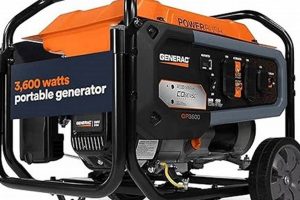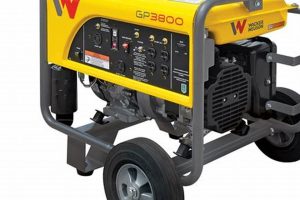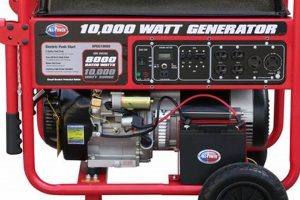Determining the appropriately sized generator for powering a portable air conditioner involves careful consideration of the AC unit’s power requirements. These requirements are typically measured in watts and are often found on a label affixed to the appliance or in its user manual. For example, a 10,000 BTU portable AC might require 1,200 running watts and a surge wattage of 2,000 upon startup. Understanding both running and surge wattage is critical, as the generator must be capable of handling both.
Matching a portable air conditioner with a correctly sized generator ensures reliable operation and prevents damage to both devices. An undersized generator may struggle to start the AC or could overload and shut down during operation, potentially harming the generator and the air conditioner. Historically, portable generators have become increasingly crucial during power outages, providing a means to maintain comfort and safety, particularly in extreme weather. This makes accurate generator sizing essential for emergency preparedness.
Several factors influence the generator size needed. These include the specific BTU rating and wattage requirements of the air conditioner, the potential use of other appliances simultaneously with the AC, and the availability of various generator sizes and fuel types. A deeper exploration of these factors will provide a more comprehensive understanding of how to choose the best generator for individual needs.
Tips for Selecting a Generator for a Portable Air Conditioner
Selecting the correct generator size for a portable air conditioner involves several key considerations. Following these tips will ensure reliable operation and prevent potential damage to equipment.
Tip 1: Determine Air Conditioner Wattage: Locate the air conditioner’s wattage requirements on the appliance label or in the owner’s manual. Note both the running wattage and the surge wattage.
Tip 2: Account for Starting Wattage: Generators must be capable of handling the higher surge wattage required when the air conditioner starts. This surge is typically significantly higher than the running wattage.
Tip 3: Consider Additional Appliances: If other appliances will run simultaneously with the air conditioner, calculate their combined wattage and add it to the air conditioner’s requirements.
Tip 4: Choose a Generator with Sufficient Capacity: The generator’s running wattage capacity should exceed the combined wattage of all intended appliances, including the air conditioner’s surge wattage.
Tip 5: Research Generator Types: Explore inverter generators, which offer more stable power and fuel efficiency, particularly for sensitive electronics. Conventional generators are a more cost-effective option for less sensitive devices.
Tip 6: Factor in Fuel Type and Runtime: Consider the availability and cost of fuel (gasoline, propane, etc.) and the desired runtime. Larger fuel tanks offer longer operation between refills.
Tip 7: Consult a Qualified Electrician: For complex setups or if uncertainty remains, consulting a qualified electrician can provide expert guidance and ensure safe installation.
Proper generator selection ensures reliable power for portable air conditioners, preventing equipment damage and maintaining comfort during outages. Careful consideration of these factors will lead to an informed decision.
By following these guidelines, users can confidently select a generator that meets their specific needs and ensures reliable operation of their portable air conditioner.
1. Running Watts
Running watts represent the continuous power an appliance requires during operation. This metric is crucial when determining the appropriate generator size for a portable air conditioner. The generator’s running watt rating must exceed the AC unit’s running watts to ensure consistent and reliable performance. For example, a portable air conditioner with a running wattage of 1000 watts requires a generator with a running wattage rating above 1000 watts. Attempting to operate this AC unit with a smaller generator could lead to overloading and potential damage to both the generator and the air conditioner. Insufficient running watts may also cause the generator to stall, leaving the AC unit without power.
The relationship between running watts and generator sizing extends beyond simply exceeding the AC unit’s requirements. Consideration must also be given to any additional appliances that might run concurrently with the air conditioner. The cumulative running watts of all devices intended for simultaneous use must be less than the generator’s rated running wattage. For instance, if a television with a running wattage of 150 watts is used alongside the 1000-watt air conditioner, the generator must supply at least 1150 running watts. This ensures adequate power for all appliances without overloading the generator. Overlooking this cumulative load is a common mistake that can lead to power disruptions and equipment damage.
Understanding the importance of running watts is fundamental to proper generator selection and safe operation. Failure to account for running watts can result in generator overload, appliance malfunction, and potential safety hazards. Careful calculation of the total running wattage requirements, including all intended appliances and potential future additions, is essential for ensuring reliable power delivery and preventing costly repairs or replacements. Selecting a generator with ample running wattage provides a buffer for unexpected load increases and contributes to the longevity of both the generator and the powered devices. This proactive approach ensures preparedness and avoids the inconveniences and potential dangers associated with power shortages.
2. Starting Watts (Surge)
Starting watts, also known as surge watts, represent the brief but significantly higher power demand required to start an electric motor. This surge is particularly relevant to appliances like portable air conditioners, which utilize a compressor motor. Understanding the relationship between starting watts and generator sizing is crucial for reliable AC operation. The generator’s starting wattage capacity must exceed the AC unit’s surge wattage to successfully power the unit on. A mismatch, where the generator’s starting wattage is lower than the AC’s surge wattage, can lead to several issues. The generator may stall upon startup, fail to power the AC, or even sustain damage due to overload. The air conditioner’s compressor might also be damaged if insufficient power is available during startup. For example, a portable air conditioner with a surge wattage of 2000 watts requires a generator capable of providing at least 2000 starting watts. A generator rated for only 1500 starting watts would likely be insufficient to start the AC unit reliably.
The practical significance of this understanding is substantial. Selecting a generator with adequate starting wattage ensures consistent and reliable operation of the portable air conditioner. Ignoring surge wattage can result in frustrating power failures, particularly during critical situations like power outages. Furthermore, using an undersized generator can lead to costly repairs or replacements of both the generator and the air conditioner. Investing in a generator with sufficient starting wattage provides peace of mind and ensures the air conditioner functions when needed most. Practical applications include disaster preparedness, camping, and off-grid living. In these scenarios, reliable power for essential appliances like portable air conditioners can be crucial for maintaining comfort and safety.
In summary, starting watts are a critical factor in determining the appropriate generator size for a portable air conditioner. The generator’s starting wattage must meet or exceed the air conditioner’s surge wattage. This ensures reliable operation and prevents potential damage to both devices. Careful consideration of starting wattage alongside running wattage, when selecting a generator, is essential for a successful and trouble-free power supply for portable air conditioners and other motor-driven appliances. Neglecting this aspect can compromise the effectiveness and longevity of both pieces of equipment.
3. Air Conditioner BTU
British Thermal Units (BTU) represent an air conditioner’s cooling capacity. A direct relationship exists between BTU and the electrical power required to achieve that cooling capacity, influencing the necessary generator size. Higher BTU ratings generally correlate with increased power consumption, measured in watts. Consequently, portable air conditioners with higher BTU ratings demand generators capable of delivering more power. A 5,000 BTU unit typically requires less power than a 10,000 BTU unit. This underscores the importance of considering BTU when determining the appropriately sized generator. For instance, a small 5,000 BTU portable air conditioner might require a generator capable of delivering 500 running watts and 1000 starting watts, while a larger 10,000 BTU unit might necessitate a generator providing 1000 running watts and 2000 starting watts. Overlooking the BTU rating can lead to an undersized generator, resulting in insufficient power supply and potential damage to both the generator and the air conditioner.
Understanding this relationship allows for practical application in various contexts. When selecting a generator for emergency home cooling, camping, or off-grid living, matching the generator’s output to the air conditioner’s BTU rating ensures efficient and reliable operation. This knowledge empowers informed decisions, avoiding the inconvenience and potential hazards of an underpowered system. Further considerations include potential simultaneous use of other appliances alongside the air conditioner, which increases the overall power demand placed on the generator. Calculations should always account for the cumulative wattage requirements of all intended devices, not solely the air conditioner.
In summary, air conditioner BTU ratings directly impact generator sizing requirements. Higher BTU ratings necessitate generators with greater power output capabilities. This understanding is fundamental for selecting a generator capable of reliably powering a specific portable air conditioner. Considering both running and starting wattage requirements, in conjunction with the BTU rating, ensures optimal performance and prevents equipment damage. Neglecting this relationship can lead to operational issues and potentially compromise safety and comfort, particularly during critical situations where reliance on a portable air conditioner is paramount.
4. Additional Appliance Load
Additional appliance load significantly impacts generator sizing for portable air conditioners. Operating other appliances concurrently with the AC unit increases the overall power demand placed on the generator. Calculating the necessary generator size requires summing the running wattage of all intended devices, including the air conditioner. Neglecting this cumulative load can lead to generator overload, potentially damaging both the generator and connected appliances. For example, running a refrigerator (150 running watts), a television (100 running watts), and a 1000-watt portable AC simultaneously necessitates a generator capable of supplying at least 1250 running watts. Furthermore, the generator’s starting wattage must also accommodate the highest surge wattage among all appliances, often the air conditioner’s.
Practical implications arise when powering multiple devices during power outages or in off-grid scenarios. Prioritizing essential appliances and staggering their usage can mitigate overload risks. Using a power consumption meter helps accurately assess individual appliance wattage. Prioritizing devices based on necessity helps conserve power. For instance, during a power outage, operating the air conditioner and refrigerator might take precedence over less critical appliances. Understanding the impact of additional loads enables effective power management and prevents potential equipment damage. This proactive approach is crucial for emergency preparedness and sustainable off-grid living.
In summary, accurate generator sizing for portable air conditioners demands careful consideration of the aggregate power consumption of all intended appliances. Failure to account for additional loads can lead to generator overload and equipment damage. Prioritizing essential appliances and employing power management strategies helps optimize generator usage, ensuring reliable power delivery during outages or off-grid operation. This comprehensive approach safeguards equipment and ensures access to essential services when relying on generator power.
5. Generator Fuel Efficiency
Generator fuel efficiency plays a crucial role in determining the practicality and cost-effectiveness of running a portable air conditioner. Fuel efficiency is typically measured in gallons per hour (GPH) and represents the rate at which a generator consumes fuel. This directly impacts runtime and operating expenses. Selecting a generator with appropriate fuel efficiency is essential for ensuring a sustainable and economical power solution for portable AC units.
- Fuel Consumption Rate:
Generators vary significantly in their fuel consumption rates. A less fuel-efficient generator will consume more fuel per hour of operation, leading to increased fuel costs and more frequent refueling. This is a critical consideration for extended use, such as during prolonged power outages or in off-grid scenarios. For instance, a generator consuming 1 GPH will require twice as much fuel as a generator consuming 0.5 GPH over the same operating period. This difference can translate into substantial cost savings and logistical advantages, especially in remote locations or during emergencies.
- Runtime and Tank Capacity:
Fuel tank capacity and fuel consumption rate determine the generator’s runtime. A larger fuel tank combined with a lower fuel consumption rate allows for longer operation between refills. This is particularly advantageous for overnight power supply or in situations where refueling is difficult or inconvenient. Choosing a generator with sufficient runtime capacity is essential for maintaining uninterrupted air conditioning, especially during critical periods. For example, a generator with a 5-gallon tank consuming 0.5 GPH will provide 10 hours of runtime, while a generator with the same tank size but consuming 1 GPH will only run for 5 hours.
- Inverter Technology and Efficiency:
Inverter generators generally offer better fuel efficiency compared to conventional generators. They adjust engine speed based on power demand, reducing fuel consumption when the load is lower. This makes them a more economical choice for powering portable air conditioners, particularly when the AC unit does not consistently operate at its maximum power draw. Inverter generators can also provide cleaner power, which is beneficial for sensitive electronic devices.
- Load Management and Fuel Efficiency:
Managing the load placed on the generator can significantly impact fuel efficiency. Avoid running unnecessary appliances simultaneously with the portable air conditioner to minimize fuel consumption. Using energy-efficient appliances further reduces the load and optimizes fuel usage. For instance, using LED lighting instead of incandescent bulbs reduces the overall power demand, leading to extended generator runtime and lower fuel costs.
Careful consideration of generator fuel efficiency is paramount when selecting a generator to power a portable air conditioner. Balancing fuel consumption rate, tank capacity, and load management ensures a cost-effective and sustainable power solution. Prioritizing fuel-efficient generators, particularly inverter models, contributes to lower operating costs and reduced environmental impact. This holistic approach ensures reliable and economical air conditioning, especially in scenarios where continuous power is essential.
6. Inverter vs. Conventional
Generator selection for portable air conditioners often involves choosing between inverter and conventional generator types. This decision significantly impacts fuel efficiency, power quality, noise levels, and overall cost. Understanding the distinctions between these generator types is crucial for selecting the optimal power source for a portable AC unit.
- Power Quality:
Inverter generators produce cleaner, more stable power, resembling the consistent power delivered by utility companies. This “clean power” is particularly beneficial for sensitive electronic devices commonly found in portable AC units. Conventional generators, conversely, produce power with fluctuating voltage and frequency, potentially posing risks to sensitive electronics. While some portable AC units can tolerate these fluctuations, others might experience performance issues or even damage. Therefore, inverter generators offer a safer and more reliable power source for sensitive electronic components within portable AC units.
- Fuel Efficiency:
Inverter generators typically exhibit superior fuel efficiency compared to their conventional counterparts. They achieve this through variable engine speed, adjusting the engine’s output to match the power demand. At lower loads, the engine slows down, conserving fuel. Conventional generators, on the other hand, operate at a fixed speed regardless of the load, resulting in higher fuel consumption, particularly at lower power demands. This variable speed operation makes inverter generators more economical for powering portable AC units, especially when the AC is not consistently running at full capacity.
- Noise Levels:
Inverter generators generally operate at lower noise levels than conventional generators. The variable engine speed allows the engine to run quieter at lower loads. This is a significant advantage in noise-sensitive environments such as residential areas or campgrounds. Conventional generators, with their fixed engine speed, tend to produce consistent and often louder noise levels, regardless of the power demand. This difference can be substantial, making inverter generators a preferable option for users prioritizing quiet operation.
- Cost:
Conventional generators typically have a lower initial purchase price compared to inverter generators. However, the long-term operating costs, primarily fuel consumption, can be higher for conventional generators, especially with extended use. Inverter generators, while more expensive upfront, offer potential long-term savings through reduced fuel consumption. The overall cost-effectiveness depends on the intended usage patterns. For occasional use, a conventional generator might be sufficient, but for frequent or prolonged use, an inverter generator’s fuel efficiency can result in significant cost savings over time.
Selecting between an inverter and conventional generator for a portable air conditioner involves balancing power quality, fuel efficiency, noise levels, and cost considerations. Inverter generators offer advantages in terms of clean power, fuel efficiency, and quiet operation, but come at a higher initial cost. Conventional generators provide a more budget-friendly initial investment but might incur higher operating costs and pose potential risks to sensitive electronics. Careful evaluation of these factors, alongside specific power requirements and usage patterns, ensures the most suitable generator selection for powering a portable AC unit effectively and efficiently.
Frequently Asked Questions
This FAQ section addresses common inquiries regarding generator sizing for portable air conditioners. Understanding these key points ensures proper equipment selection and safe operation.
Question 1: How is the required generator size determined for a portable air conditioner?
The required generator size is determined by the air conditioner’s running wattage and surge wattage, plus the wattage of any other appliances intended for simultaneous use. The generator’s running wattage must exceed the combined running wattage of all devices, and its surge wattage must exceed the highest starting wattage among those devices.
Question 2: What are the consequences of using an undersized generator?
Using an undersized generator can lead to generator overload, causing it to stall or shut down. This can damage both the generator and the connected appliances, including the air conditioner. Insufficient power can also prevent the air conditioner from starting or operating effectively.
Question 3: Does the air conditioner’s BTU rating influence generator size requirements?
Yes, the BTU rating (British Thermal Units) directly relates to the air conditioner’s cooling capacity and power consumption. Higher BTU ratings generally require more powerful generators. It is essential to consider the BTU rating alongside wattage requirements when selecting a generator.
Question 4: What is the difference between running watts and starting watts?
Running watts represent the continuous power required by an appliance during operation. Starting watts, or surge watts, represent the temporary, higher power demand needed to start the appliance’s motor. Generators must be sized to handle both running and starting wattage requirements.
Question 5: Are inverter generators better suited for portable air conditioners?
Inverter generators offer cleaner power and better fuel efficiency, which can be beneficial for portable air conditioners, particularly those with sensitive electronics. While generally more expensive, they provide more stable power and quieter operation compared to conventional generators.
Question 6: How does fuel efficiency impact generator selection?
Fuel efficiency affects the generator’s runtime and operating costs. A more fuel-efficient generator consumes less fuel per hour, leading to longer runtimes and lower fuel expenses, particularly during extended operation.
Careful consideration of these frequently asked questions ensures appropriate generator selection for reliable and safe operation of portable air conditioners. Consulting manufacturer specifications and seeking expert advice when necessary further contributes to informed decision-making.
For further information on specific generator models and their suitability for powering portable air conditioners, consult manufacturer specifications and retailer resources. This additional research will provide detailed technical information tailored to specific product offerings.
Selecting the Right Generator Size for Portable AC Units
Determining appropriate generator size for portable air conditioners requires careful consideration of several interconnected factors. Running wattage, starting wattage, and the BTU rating of the air conditioner all play crucial roles. Furthermore, anticipated additional appliance loads must be factored into the overall power requirements. Fuel efficiency and the choice between inverter and conventional generator types further influence the selection process, impacting long-term operational costs and power quality. Overlooking any of these elements can lead to inadequate power supply, equipment damage, and operational inefficiencies.
Proper generator sizing ensures reliable and safe operation of portable air conditioners, particularly during critical situations such as power outages or off-grid usage. Informed decision-making, based on a thorough understanding of these factors, leads to a robust and efficient power solution, maximizing comfort and safety while minimizing potential disruptions and costs. Careful planning and appropriate equipment selection are essential investments in preparedness and long-term operational success.






